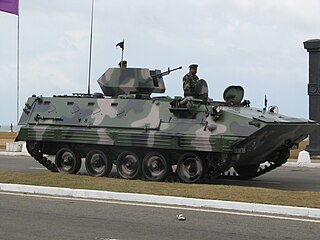
Mechanized infantry are infantry units equipped with armored personnel carriers (APCs) or infantry fighting vehicles (IFVs) for transport and combat.
A division is a large military unit or formation, usually consisting of between 10,000 and 25,000 soldiers. In most armies, a division is composed of several regiments or brigades; in turn, several divisions typically make up a corps.

The Russian Naval Infantry, often referred to as Russian Marines in the West, operate as the naval infantry of the Russian Navy. Established in 1705, they are capable of conducting amphibious operations as well as operating as more traditional light infantry.

The People's Liberation Army Ground Force is the land-based service branch of the People's Liberation Army and the largest and oldest branch of the entire Chinese armed forces. The PLAGF can trace its lineage from 1927 as the Chinese Red Army; however, it was not officially established until 1948.

The Republic of China Army (ROCA), also known as the ROC Army and unofficially as the Taiwanese Army, is the largest branch of the Republic of China Armed Forces. An estimated 80% of the ROC Army is located on Taiwan, while the remainder are stationed on the Penghu, Kinmen, Matsu, Dongsha and Taiping Islands.

The Hungarian Ground Forces constitute the land branch of the Hungarian Defence Forces, responsible for ground activities and troops, including artillery, tanks, Armoured Personnel Carriers (APCs), Infantry Fighting Vehicles (IFVs), and ground support. The ground forces have a history of service in Iraq and are currently engaged in the KFOR operation.

The WZ-551 is a Chinese wheeled infantry fighting vehicle family. The name WZ-551 actually covers two families of vehicles with the official designations in the People's Liberation Army (PLA) – Type 90 and Type 92. Over 3,000 WZ-551s are in service with the PLA, where they are used by medium mechanized infantry units.

The Bulgarian Land Forces are the ground warfare branch of the Bulgarian Armed Forces. It is administered by the Ministry of Defence, previously known as the Ministry of War during the Kingdom of Bulgaria. The Land Forces were established in 1878, when they were composed of anti-Ottoman militia (opalchentsi) and were the only branch of the Bulgarian military.
List of abbreviations, acronyms and initials related to military subjects such as modern armour, artillery, infantry, and weapons, along with their definitions.

The Ukrainian Marine Corps, also known simply as the Ukrainian Marines, is the maritime land force service branch of the Armed Forces of Ukraine since 2023, responsible for conducting expeditionary and amphibious operations. From its modern foundation in 1993 up to 2023 it constituted part of the Coastal Forces of the Ukrainian Navy. It is used as a component part of amphibious, airborne and amphibious-airborne operations, alone or in coordination with formations and units of the Ground Forces in order to capture parts of the seashore, islands, ports, fleet bases, coast airfields and other coast objects from the enemy. It can also be used to defend naval bases, vital shoreline areas, separate islands and coast objects, and security of hostile areas.

The Norinco Type 89 tracked armoured fighting vehicle is a Chinese armoured personnel carrier. It was developed from the earlier export market Type 85 AFV vehicle. It entered service in the late 1990s and was first shown publicly in 1999. There are approximately 1,000 in service. It has the industrial index of WZ534 and although it was mainly developed for the PLA, there is also an export version YW534.

The Yugoslav Ground Forces was the ground forces branch of the Yugoslav People's Army (JNA) from 1 March 1945 until 20 May 1992 when the last remaining remnants were merged into the Ground Forces of the new Federal Republic of Yugoslavia, under the threat of sanctions.

The Type 05 amphibious armored vehicle is a family of amphibious tracked armored fighting vehicles developed by Norinco for the People's Liberation Army Navy Marine Corps, consisting of two main combat variants — the ZBD-05 infantry fighting vehicle and the ZTD-05 assault vehicle, as well as several support variants based on the ZBD-05. The Type 05s could be launched at sea from an amphibious assault ship over the horizon, and features a hydroplane, a design concept that has been compared to the cancelled United States Expeditionary Fighting Vehicle (EFV) program.

The Type 08 is a family of eight-wheeled amphibious, modular armored vehicle developed by Norinco for infantry fire support, battlefield logistics, and quick reaction operations. Developed in the early 2000s, the modern Chinese vehicle family were produced for more than 6000 hulls and widely deployed by the People's Liberation Army Ground Force and People's Liberation Army Marine Corps.
The 1st Amphibious Combined Arms Brigade, formerly the 1st Amphibious Mechanized Infantry Division, is a military formation of the People's Liberation Army Ground Force of the People's Republic of China.
The 10th Tank Division was formed in August 1967 with the 4th Independent Tank Regiment, 284th Tank Self-Propelled Artillery Regiment from the 79th Army Division and the 286th Tank Self-Propelled Artillery Regiment from the 81st Army Division.

The 2nd Heavy Combined Arms Brigade, originally the 2nd Tank Division, the 2nd Armored Division and the 2nd Armored Brigade, is an armored formation of the People's Liberation Army Ground Force of the People's Republic of China.
The 145th Division was created in November 1948 under the Regulation of the Redesignations of All Organizations and Units of the Army, issued by Central Military Commission on November 1, 1948, basing on the 34th Division, 12th Column of the PLA Northeastern Field Army. Its history can be traced to Eastern Harbin Security Command, formed in September 1945.

The People's Liberation Army Air Force Airborne Corps is an airborne corps under direct command of the People's Liberation Army Air Force (PLAAF). It was reorganized and renamed from the 15th Airborne Corps in May 2017 and now comprises six airborne brigades and a special operations brigade. The PLAAF Airborne Corps is China's primary strategic airborne unit and part of the newly formed rapid reaction units (RRUs) of the Chinese military which is primarily designated for airborne and special operation missions. Its role is similar to that of the U.S. Army's XVIII Airborne Corps, the British Army's Parachute Regiment and the Russian Airborne Forces.





















